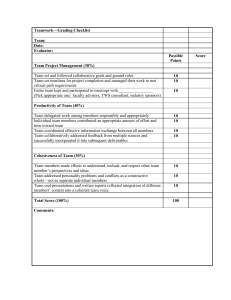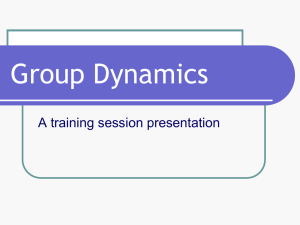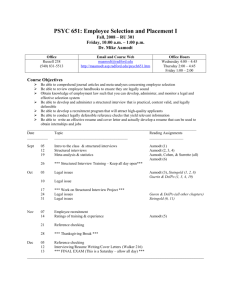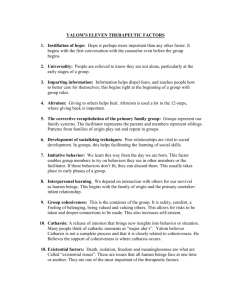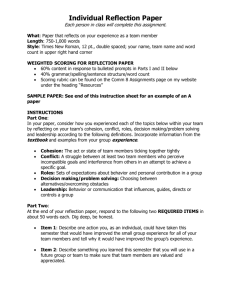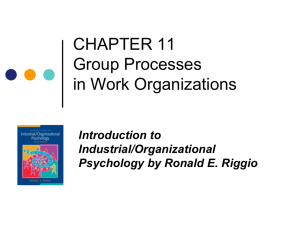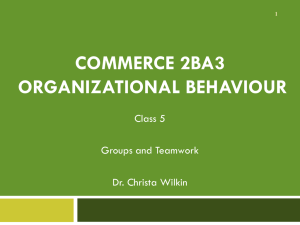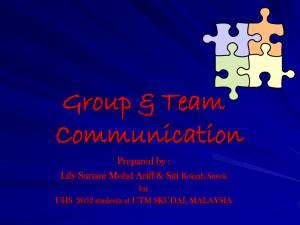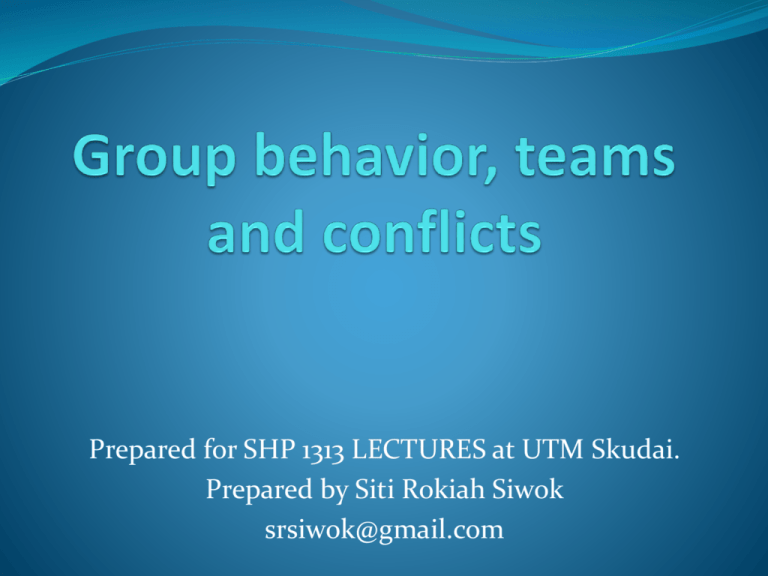
Prepared for SHP 1313 LECTURES at UTM Skudai.
Prepared by Siti Rokiah Siwok
srsiwok@gmail.com
Introduction
Employee seldom work in isolation ( Mullins, 2006).
Groups are characteristics of all social situations
( Mullins, 2006).
Most employee behaviour takes place in groups or
teams; thus important to understand group dynamics
(Aamodt, 2007)
People in groups influence each other in various ways.
Groups may develop hierarchies and leaders .
Style of leadership affect groups.
Introduction
Groups are crucial to the functions of work
organizations because through work groups :
Members can pool their resources (talents , energy etc)
Provide professional identities for members
Satisfies the human need for social interaction
Develop of interpersonal relationship on the job
Help establish rules for proper behaviour in the work
setting and thus play a role in determining the course of
action the work and the organization will follow.
( Riggio, 2009)
Definition of a group
No agreed definition.
Any no. of people interacting with one another,
psychologically aware of one another and perceived
themselves to be in a group ( Schein, 1988 in Mullins
2006).
A group is two or more individuals engaged in social
interaction to achieve some goal (Riggio, 2009)
A definable membership, group consciousness, shared
purpose, interdependence, interaction and ability to
act in a unitary manner ( Adair, 1986 in Mullins 2006)
Definition of a group
Four criteria must be met (Gordon, 2001 in
Aamodt, 2010):
Members see themselves as a unit
Group must provide rewards to members
Members of the group share a common goal
Corresponding effects(whatever happens to a
member affects every other member).
Groups and Norms
Norms are rules that groups adopt governing
appropriate and inappropriate behavior for
members.
Norms have several purposes, they:
Facilitate group production.
Increase prediction of group member
behavior.
Provide a sense of identity to the group.
Basic Group Process: Conformity
Conformity is the process of adhering to
group norms.
Conformity is often very strong and helps
maintain order and uniformity in group
behavior.
Extreme and repeated norm violation results in
ostracism from the group.
Members who have more power (e.g., the
group leader) or who usually conform to norms
are more likely to be successful in
nonconforming behavior.
Basic Group Processes: Group efficacy
Group efficacy is a group’s shared belief that they can
attain organizational outcomes.
Individual member self-efficacy contributes to
group efficacy, which in turn increases cohesiveness
and productivity (Pescosolido, 2003, in Riggio
2009).
Group efficacy is a better predictor of group
performance than the sum of individual members’
self-efficacy.
Group efficacy enhances job satisfaction and
organizational commitment.
Leaders can have an important effect on group
efficacy (Walumbwa et al., 2004, in Riggio 2009).
Basic Group Processes
Cooperation is very likely in work groups
because it is difficult to accomplish work goals
alone.
Cooperation is often based on the reciprocity
rule, the tendency for persons to pay back
those to whom they are indebted for
assistance.
Cooperation increases with task
interdependence, the degree to which an
individual’s task performance depends on the
efforts/skills of others.
Social loafing occurs when individuals
working in groups exert less effort than when
they work alone.
Basic Group Processes : Competition
Competition is the process whereby group
members are pitted against one another to
achieve individual goals.
Wage systems in the U.S. and internationally
are often competitive in nature (e.g., bonuses,
promotions available).
While competition may increase motivation to
perform, the introduction of competition when
goals are already set may lead to a decrease in
performance (Campbell & Furrer, 1995).
Reasons for joining a group
Assignment
Physical proximity
Affiliation (to fulfill the need to be with people)
Identification
Emotional support
Assistance or help
Common interest
Common goals
Factors affecting Group
Performance
Group cohesiveness
Group homogeneity
Stability of membership
Isolation
External pressure
Group size
Group status
Group ability and
confidence
Personality of group
members
Communication network
Group roles
Presence of others
Individual dominance
Groupthink
Factors affecting Group
Performance: Cohesiveness
Group cohesiveness
It is the extent to which group members like and trust
each other, committed to accomplish a team goal and
share a feeling of group pride ( Beale, Cohen, Burke &
McLendon, 2003 in Aamodt, 2010)
Cohesiveness is the degree of attraction among group
members ( Riggio, 2009)
Cohesiveness
Cohesiveness increases member satisfaction, but
only increases productivity when it is work-related.
Cohesiveness increases when group members have
equal status.
Cohesiveness increases with increased stability of
group membership.
Greater similarity of group members increases
cohesiveness.
The we-they feeling is cohesiveness created by the
existence of a threat to the group.
Group Cohesiveness
Group Cohesiveness are influenced by many
elements:
1. Group homogeneity
It is the extent to which members are similar
Homogeneous or heterogeneous will lead to the best
group performance?
2. Stability of membership
The greater the stability, the greater the cohesiveness
Thus members who remain for long periods of time are
more cohesive and perform better than groups that have
high turnover (Bell, 2005 in Aamodt, 2007)
Group Cohesiveness
3. Isolation
Group that is isolated tends to be highly cohesive
4. External pressure
Groups that are pressured by external forces tend to be highly
cohesive; which can be explained by the phenomena
psychological reactance ( Brehm, 1966 in Aamodt, 2007)
5. Group size
Groups are most cohesive and perform best when the size is
small.
However, not all small group are always the best; also depends
on the tasks.
Group cohesiveness: Group Size
Smaller is best for cohesiveness
Performance depends on task type
additive tasks
conjunctive tasks
disjunctive tasks
17
Group Size and tasks
Additive tasks are the those for which the group’s
performance is equal to the sum of the performances
by each group member.
Each group member’s contribution is important.
Larger group is better than small group
Group Size and tasks
Conjunctive tasks are those for which group’s
performance depends on the least effective group’s
member. Smaller groups are best.
Disjunctive tasks are those for which the group’s
performance is based on the most talented group
members. Larger groups are better.
Examples of Task Types
Task Type
Group Activity
Additive
Typing pool
Relay race
Bowling team
Car washing
Disjunctive
Problem solving
Brain storming
Golf tournament
Conjunctive
Assembly line
Hiking
20
Group Size: variations
The additional of a new member to a group has the
greatest effect when the group is small. Example: a
single great player can turn a poor basketball into a
victorious team.
The effect of size is also different with different
apparatus used. Example:
With the use of computers, larger groups appear
to perform best and members are most satisfied
(Dennis, Valacich and Nunamaker, 1990 etc in
Aamodt, 2010)
Group Cohesiveness
6. Group status
The higher the group status, the greater is the
cohesiveness; thus a group can be made more cohesive
by increasing its status, at least in the eyes of the
members.
Factors affecting Group
Performance
Group ability and confidence
Groups with high-ability members outperform groups
with low-ability members
Groups whose members believe that their team can be
successful perform better than those whose members
are not confident.
Personality of group members
Groups with members who score high in openness and
emotional stability will perform better that groups
whose members do not have these characteristics ( Bell,
2005 in Aamodt, 2007)
Factors affecting Group
Performance
Communication network
Communication network affects groups’ performance
The best network depends on the situation and the goals
of the group.
A good leader must choose the best communication
network which facilitates the achievement of the group’s
goals.
Communication Structure
Chain
Bob
Jill
Peggy
Centralized
Jill
Peggy
Bob
Circle
Jill
Peggy
Bob
Open
Jill
Peggy
Bob
25
Factors Affecting Group Performance:
Group Roles
Roles are patterns of behavior that are
adapted based on expectations about the
functions of a position in a group.
Role expectations are beliefs concerning the
responsibilities and requirements of a
particular role.
Role differentiation is the process by which
group members learn to perform various
roles.
(Riggio, 2009)
Roles
Early researchers (Benne and Sheats, 1948)
identified three categories of work roles in
groups.
Group task roles are related to getting the job
done (e.g., leader, evaluator).
Group building and maintenance roles deal
with maintaining personal relationships
among members (e.g., encourager,
compromiser).
Self-centered roles involve satisfying personal
rather than group goals (e.g., recognition
seeker, aggressor).
Riggio, 2009, page 310
(Riggio, 2009 page 310)
Roles
Role ambiguity involves a sense of
uncertainty over the requirements of a
particular role.
Role conflict results when the
expectations associated with one role
interfere with the expectations
concerning another role.
Roles
Organizational socialization is the process
by which new employees learn group roles
and norms and develop specific work skills
and abilities.
Organizational socialization occurs in stages.
Anticipatory socialization: new employees
develop expectations concerning the job and
assess they “fit” in the organization.
Accommodation: new employees learn about
work group roles and norms.
Role management: newcomers transition to
regular members.
Factors Affecting Group
Performance: Presence of Others
Social Facilitation and Inhibition
mere presence of others
comparison of performance
evaluation apprehension
distraction
Social Loafing
effort won’t be noticed
free-rider theory
sucker-effect theory
32
Factors affecting Group Performance
:Individual Dominance
By the group leader
If the leader has an accurate solution
to a problem in the group, then the
group performs at high level.
By a group member
33
Factors affecting Group
Performance: Groupthink
Groupthink is a syndrome characterized by a
concurrence-seeking tendency that overrides the
ability of a cohesive group to make critical
decisions.
Factors affecting Group
Performance: Groupthink
Can occur when the group :
is cohesive
is insulated from outsiders
believes it is infallible
it is morally superior
is under pressure to conform
has a leader who promotes a
favorite solution
has gatekeepers who keep
information from members
(Aamodt, 2010)
35
Riggio, 2009, page 334
Group versus Individual
Performance
When several people work individually on a problem
but do not interact, they are called nominal group.
When several individuals interact to solve problems
are called interacting group.
Research shows that interacting group will usually
outperform one individual, but interacting groups do
not outperform nominal groups ( Kerr and Tinsdale,
2004 in Aamodt 2010)
Group versus Individual
Performance
Interacting Groups
Are more risky
Individuals (nominal groups)
Are more creative and higher quality ( comparison
using brainstorming activities)
Make a decision more quickly
38
Nominal versus Interacting groups
There is a tendency for interacting groups to take more
extreme positions than the positions of individual
members. This tendency is called polarization.
Thus : Group polarization is the tendency for groups
to make decisions that are more extreme than those
made by individuals ( Riggio, 2009)
Nominal versus Interacting groups
The superiority of nominal group over interacting
groups may depend on the type of task.
Wilson (2007 in Aamodt, 2010) criticizes the
results of research which seem to conclude the
superiority of nominal over interacting groups. He
believes that the tasks were too easy and if the
tasks were difficult, the interacting group are
superior.
Groups or teams?
Groups or teams?
Not all groups are teams.
“ Teams occurs when a number of people have a
common goal and recognize that their personal
success is dependent on the success of others. They are
all interdependent…” ( Crainer, 1998, in Mullins 2006)
Teams verses groups
Teams are more likely to consist of people with diverse
abilities, with their own specialization and different
perspectives to ensure the completion of a common
task. Eg: a surgical team.
Teams usually develops more interdependence
compared to groups.
Members in teams have high degree of group identity
and thus more like to identify themselves as a team.
ALL TEAMS CONSIST OF GROUPS, BUT NOT ALL
GROUPS ARE TEAMS.
43
Comparison :Group and team
TEAM
GROUP
Size
Limited
Medium or large
Selection
Crucial
Immaterial
Leadership
Shared or rotating
Solo
Perception
Mutual knowledge
understanding
Focus on leader
Style
Role spread
coordination
Convergence
conformism
Spirit
Dynamic interaction
Togetherness
persecution of
opponents
(Belbin, 2000 in Mullins 2006)
Teams
45
What is a Team?
Donnellon (1996)
Identification
Interdependence
Power differentiation
Social distance
Conflict management
tactics
Negotiation process
46
Teams and Teamwork
A team is an interdependent group of
workers with complementary skills working
toward shared goals.
Teams are most appropriate for complex tasks,
complex decision-making, or creative tasks.
Teams are also appropriate when the situation
is variable, requiring the team to adapt to
changing external conditions.
Self-managing work teams have complete
responsibility for whole work tasks.
(Riggio, 2009 )
Riggio, 2009, page 338
Types of Teams
Work Teams
Parallel Teams
Project Teams
Management Teams
49
Types of Teams
Project Teams
Work Teams
Focus Group
Parallel Teams
Management Teams
50
Project Teams
Exists in almost every type of organization.
Consists of variety of individuals who get together
to solve problems or make decisions.
In project teams, the individuals are usually
specially assigned to coordinate the successful
completion of an assigned task. Example: a
student affairs administrator or a campus police
detective.
Usually work under a dateline and work fast.
Work Teams
Exists in almost every type of organization.
Consists of variety of individuals who get together
to solve problems or make decisions.
Is a group of people who are responsible for the
entire work process or segment of the process that
delivers a product or service to an internal or
external customer.
Usually are subdivisions of a larger group; can exist
for an indefinite period of time or until a specific
project is completed.
Work teams
Work teams can also serve many purposes, including
solving problems, making decisions, socializing and
learning.
Groups and Teams
Although there are distinctions between groups and
teams, the differences are not dramatic.
Exist on a continuum, some have more characteristics
of a group, while others resemble more of a team.
(Sieler and Beall, 2011, page 414)
Work Team : Focus Group
Focus group is a special form of work team.
Usually consists of a manageable number of
participants plus a facilitator or leader
The goal for the formation of the team is to find
out what the members think about specific ideas,
issues or people.
Information obtained will be analysed and used
for decision making.
How Teams Develop
Tuckman (1965) Theory
Forming
Team members get to know one another
Everyone is on their good behavior
Group clarifies its mission
Storming
Disagreement and frustration set in
Norming
Group members work at easing tension
Acceptance of team leader
Performing
Goals get accomplished
56
How Teams Develop
Punctuated EquilibriumTheory (Gersick, 1988)
Teams do not go through set stages
Basic method of formation
Develop direction and strategy during first meeting
Follow this direction for a period of time
Revise their strategy about half way thorough the life of
the team
57
Why Teams Don’t Always Work
The team is not a team
Excessive meeting requirements
Lack of empowerment
Lack of skill
Distrust to the team process
Unclear objectives
58
Conflict
Group conflict
Working together in a group or teams always presents
the potential for the occurrence of conflicts.
Key component to conflict is perception.
The level of conflict is a function of the importance of
the goal, behavior or relationship.
Conflict : Definition
Conflict is a psychological and behavioral
reaction to a perception that another
person is
Keeping you from reaching a goal
Taking away your right to behave a certain way
Violating the expectancies of a relationship
61
Conflict can be……
Functional
Dysfunctional
Dysfunctional and functional
conflicts
Most conflicts results in lower team performance, and
lower members satisfaction,
Most conflicts are dysfunctional , as the conflicts
prevents people from working together, lessens
productivity and increases turnover.
Moderate degree of conflict , called functional
conflicts can result in better performance- stimulate
new ideas, increase friendly competition and increase
team effectiveness.
Moderate conflicts reduce the risks of larger conflicts.
Consequences of Dysfunctional
Conflict
Decreased productivity
Low morale
Absenteeism
Stress
Turnover
Law suits
Violence
64
Types of conflicts
Interpersonal conflict
Individual – group conflict
Group –group conflict
Causes of Conflict
1.
2.
3.
4.
Competition for resources
Task interdependence
Jurisdictional ambiguity
Communication barriers
Physical
Cultural
Psychological
5. Beliefs
6. Personality
( Aamodt, 2010)
67
Personalities:
Types of Difficult People
Type
Need
Description
Tank
Control
Pushes, yells, intimidates
Sniper
Control
Uses sarcasm, criticizes
Know-it-all
Control
Dominates conversations
Whiner
Perfection
Constantly complains
No person
Perfection
Disagrees with everything
Nothing person
Perfection
Doesn’t do anything
Yes person
Approval
Agrees to everything
Maybe person
Approval
Won’t commit or make a decision
Grenade
Attention
Throws tantrums
Friendly sniper
Attention
Uses jokes to pick on others
Think-they-know-it-all
Attention
Exaggerates, lies, gives advice
68
Dealing with Difficult People
Direct Intervention
address behavior
explain impact of behavior on
others
Indirect Intervention
positive feedback when
appropriate behavior is used
Direct Coping
separate difficult employee from
others
Indirect Coping
provide training to others on
dealing with difficult personality
69
Resolving conflict
Prevention /prior to conflict occurrence
When conflict first occurs
Third -party intervention
Preventing Workplace Conflict
An organization should have a formal policy on how
conflict to be handled, which states that :
Employees should first try to resolve their own conflicts
If the above is not successful, employees can utilize a
third party intervention
Employees should receive training on the causes of
conflict, ways to prevent conflict and strategies to
resolve it.
Preventing Workplace Conflict
Well-written job descriptions
Unambiguous policies
Clarification of roles and
expectations
Training on new policies
Conflict management
training
For teams, clarification of
levels of authority
73
When conflict FIRST occurs
The two parties should be encouraged to use conflict
resolution skills which they had learned. These skills
include:
Expressing a desire for cooperation
Offering compliments
Avoiding negative interaction
Emphasizing mutual similarities
Highlighting common goals
When conflict FIRST occurs
Key to resolving conflict is to reduce tension and
increase trust between the two parties; which can be
accomplished by :
Stating an intention to reduce tension
Publicly announcing steps to be taken to reduce
tension.
Inviting the other side to take action in to reduce
tension.
Making sure all initiative are unambiguous.
What determines one’s responses
to conflict?
Goodwin and Griffith (2007) state that one’s
responses to conflict is determined by two
considerations:
1. How important is a particular outcome to you?
2. How important is the relationship with the
other party?
Clarifying your values is very important.
Major styles
1. Avoiding style
2. Forcing style
3. Accommodating
4. Collaborating style
5. Compromising style
(Wilmont and Hocker, 2007 in Aamodt 2010)
Conflict Continuum
I win, you lose (competition—A)
I lose or give in (accommodate—B)
We both get something
(compromise—C)
We both “win”(collaborate—D)
A
B
C
D
80
Conflict Management Style
McGraw-Hill/Irwin
©2006 The McGraw-Hill Companies, Inc.,
All Rights Reserved
Responding to conflict
Responses to Conflict: Avoidance
People will adopt avoiding approach to conflict
when the conflict is trivial to them or has little
stake in the outcome or concern with whom
there is dispute
The issues are not important to them, hope the
issues will go away.
The “cost” of engaging in the conflict is not
worth the possible benefit to be gained
Needs to buy time such as to gather information
Responses to Conflict: Avoidance
This response is also called withdrawal or
retreating (Why?)
It is failing to engage ( Corvette, 2007)
Avoidance can be partial or total.
Common withdrawal behaviours include talking b
behind the back and forming alliance with others
( Martin and Bergmann, 1996 in Aamodt, 2010).
Withdrawal can make one feel better but …..
Responses to Conflict: Avoidance
What other variables are at play if this response
style is adopted?
Triangling is a form of avoidance and it is when the
party involved discusses the conflict with a third
party; with the hope that the 3rd party will talk to
the other person who is involved in the conflict.
What is the best course of action for a supervisor
when triangling occurs?
Responses to Conflict:
Adversarial/Forcing /Competitive
This style is a win/lose approach; does what it
takes to win, with little regard for the other party.
One of the underlying belief is that resources are
limited.
This style may range from mildly adversarial to
extremely aggressive.
Behaviour that exemplifies this approach includes
making remarks with no regard to other people's
feelings, refusing to back down, belittling the
other, using accusatory tactics and the like.
Responses to Conflict: Adversarial
Forcing/Competitive
http://www.mindtools.com/pages/article/newLDR_81.htm
Responses to Conflict: Adversarial
Forcing/Competitive
This style is self-centred.
On the extreme this style may lead to trickery and
violence.
Another behaviours which may be associated with
this approach are agreeing openly but internally
dissatisfied, and criticizing, criticizing,
defensiveness, stonewalling and contempt.
Responses to Conflict: Adversarial
Forcing/Competitive
The strategy of winning at all costs holds especially
when one party considers his/her side is correct
and the other party is incorrect.
Especially crucial when each side NEEDS the
victory to gain or retain status. Examples: union or
management conflicts.
Adversarial Forcing/Competitive:
Disadvantages and appropriateness
Damage relationships.
Create other conflicts.
Backing down difficult when involves status; more
likely to prolong conflict.
Appropriate :
in emergencies, or when there is violation of
policy/ethical or legal grounds or
When the position holder is actually correct and if
winning the conflict is more important that the possible
damage to future relationships.
Responses to Conflict:
Accommodating
This style is to give up part of you want at the
request of the other ( Corvette, 2007).
Used when a person is so earnest on settling a
conflict.
Stakes are usually high and the person is
considered cooperative ( but weak).
Responses to Conflict:
Accommodating
Low in assertiveness and high in cooperation
Appropriate to use when one party wants to show
reasonableness, develop performance, create good
will, or keep peace.
Some people use the accommodating mode when
the issue or outcome is of low importance to them.
(http://www.foundationcoalition.org/teams )
Responses to Conflict:
Accommodating
The accommodating mode can be problematic
when one uses the mode “keep a tally” or to be a
martyr.
Accommodating skills:
Forgetting your desires
Selflessness
Ability to yield
Obeying orders
(http://www.foundationcoalition.org/teams )
Responses to Conflict:
Collaboration
In cooperation or collaboration style, we are finding a way
94
to get the other person/group want and what we/our group
want.
It is consistent with win-win approach.
Both parties put their efforts ( creatively) together to meet
mutual goals.
Key behaviours are listening and expressing feelings and
desires in the best manners.
Assertiveness and respecting other peoples’ views are
essential too.
Responses to Conflict: Collaboration
The collaborating mode is high assertiveness and high
cooperation. Collaboration has been described as
“putting an idea on top of an idea on top of an idea…in
order to achieve the best solution to a conflict.”
With such a positive outcome for collaboration, some
people will profess that the collaboration mode is
always the best conflict mode to use.
(http://www.foundationcoalition.org/teams )
Responses to Conflict: Collaboration
However, collaborating takes a great deal of time
and energy. Therefore, the collaborating mode
should be used when the conflict warrants the
time and energy
(http://www.foundationcoalition.org/teams )
Collaboration
The collaborative mode is appropriate :
when the conflict is important to the people who are
constructing an integrative solution,
when the issues are too important to compromise,
when merging perspectives,
when gaining commitment,
when improving relationships, or
when learning
(http://www.foundationcoalition.org/teams )
Collaboration : Skills involved
Active listening
Nonthreatening confrontation
Identifying concerns
Analyzing input
(http://www.foundationcoalition.org/teams
Responses to Conflict:
Compromising
The person adopting this style utilizes give-and-take
strategies to enable each side to get some of what it wants
but not everything it wants.
Most conflicts are resolved through some form of
compromise so that the solution benefits both sides.
Compromise usually involves a great deal of negotiation
and bargaining.
The negotiation process begins with each side making an
offer that asks for much more than it really wants.
Each side understands what the other is doing and the
process continues until and acceptable terms are achieved (
Aamodt, 2010)
Responses to Conflict:
Compromising
The compromising mode is moderate assertiveness
and moderate cooperation.
Some people define compromise as “giving up more
than you want,” while others see compromise as both
parties winning.
(http://www.foundationcoalition.org/teams
Compromise
The compromising mode is appropriate are when:
you are dealing with issues of moderate importance,
when you have equal power status,
when you have a strong commitment for resolution, or
used as a temporary solution when there are time
constraints.
(http://www.foundationcoalition.org/teams
Compromise : Skills involved
Negotiating
Finding a middle ground
Assessing value
Making concessions
(http://www.foundationcoalition.org/teams
Choosing the appropriate style
All five styles may be used in one negotiation.
Each of the five styles can be used appropriately at
different times.
The collaborative style is usually the most effective
choice; but not all the time.
Styles may vary from person to person and from
situation to situation.
Choosing the Appropriate Style
In complex matters, containing many issues, we
may compromise on certain things while the main
approach is collaboration.
For issues not important and “ not worth” to put
your energy in, you may use “avoidance”.
Choosing the Appropriate Style
Seldom competitive/forcing is the best choice, but
a necessity when in an emergency or when you
have to “ act accordingly”, especially when the
other party is competitive.
Collaboration is most of the time the best
approach ( although not always) . It needs lots of
efforts and creativity. You may have to do what you
are not used to do.
Choosing the Appropriate Style
The optimum negotiation strategy will be determined
by the dynamic interaction of each party’ unique
personality, style of interaction, temperament;also
culture, value, needs, goals etc
Our natural negotiation style is strongly influenced by
our view of conflict and our personalities.
Creativity is always useful.
Knowing ourselves aids in developing alternative
style s as well as using our natural style to the optimum
A third-party intervention
Impasse may occur at any point in the process of
negotiation and persuasion process.
A third party may then be necessary to facilitate
agreement and resolution.
A third-party intervention can help the conflicting
parties to reach either a : mediation, arbitration or
litigation.
Dictation is also a third-party intervention that can be
used at the workplace.
108
Third Party Intervention
Dictation
Arbitration
Mediation
Litigation
109
Third Party Intervention
Dictation
Supervisor dictates the solution
Dictation is best when:
parties are irrational
no trust exists
too angry to be realistic
have mental health issues
alcohol or drugs are involved
when violent behavior is potential
parties have poor communication
skills
there are time constraints
110
Third Party Intervention
Mediation
A neutral party is asked to help both parties to reach a
mutually agreeable solution to the conflict.
Mediators do not make decision.
Mediators’ role is to facilitate communication process so as
to provide the conflicting parties safe and equitable venue
for reaching solutions.
Mediators can be employees of the organizations such as
team leader, supervisor etc or can be professional
mediators .
For mediation to be successful, both parties must agree
that there is a conflict and that a solution can be found
through working together.
Third Party Intervention
Arbitration
In arbitration, the conflicting parties involved forgo
their control over the outcome.
The arbitrator serves all the functions serves by a
mediator, plus the function of resolution.
In arbitration, the decision is made by the arbitrator
(Corvette, 2007)
The use of outside arbitrators is on the increase, to
handle discrimination claims by employees. These are
to avoid the negative publicity associated with
discrimination suits and to reduce the costs of
litigation( Aamodt, 2010).
Third Party Intervention
Arbitration
Mandatory arbitration can be effective, arbitration is
more expensive than mediation.
Arbitration can be either binding or nonbinding.
Arbitration can end conflict quickly, but usually
neither side is satisfied with the outcomes as both
would have if they settled the conflict themselves or
used mediation.
Third Party Intervention
Arbitration
Employees used arbitration when ( Arnold and
Carnevale, 1997 in Aamodt, 2010) :
Perceived that the conflict is the result intentional
behaviour by another,
Resolution of conflict has important consequences
The conflicting parties are of equal power
Some research suggests that performance may drop
and turnover increases as a result of an arbitrator’s
decision.
Third Party Intervention
Litigation
Involved parties lose control over the outcome.
This is a win-lose option, costly and time consuming.
It takes only one party to land everyone in court.
However, at times litigation is unavoidable
(Corvette, 2007)
Instruments: Determining your
Conflict management style
Organization Conflict Inventory II (Rahim
and Magner, 1995)
Cohen Conflict Response Inventory
(Cohen, 1997)
Summary
Groups consists of members who perceive
themselves as a unit a and sharer common goal
or goals.
People joining groups due to a need for affiliation,
a need for identification with success, a need for
emotional support, a need for assistance, common
goals , physical proximity and assignment.
Many factors contribute to a group success.
Summary
Teams have four developmental stages; namely
forming, storming, norming and performing.
Conflict may occur in a group and there are ways
to respond to the situation.
Conflict is part of life in a group and can be
managed wisely and successfully.
References:
Aamodt, M.G (2007). Industrial /organizational
psychology. An applied approach. Belmont, CA: Thomson.
Aamodt, M.G (2010). Industrial and organizational
psychology. An applied approach (6th ed) Belmont, CA:
Wadsworth
Mullins, L.J. ( 2006). Essentials of Organisational
Behaviour. England: Prentice Hall
Riggio, R. E. ( 2009). Introduction to
Industrial/Organizational Psychology (5th ed). New Jersey:
Pearson/Prentice Hall.
Corvette, B. A. B( 2006). Conflict Management. A Practical
Guide to Developing Negotiation Strategies.\
New Jersey: Pearson
Some useful websites
http://www.practical-management-
skills.com/conflict-in-the-workplace.html
http://sourcesofinsight.com/conflict-managementstyles-at-a-glance/
(http://www.foundationcoalition.org/teams
http://www.workplaceissues.com/arconflict.htm

